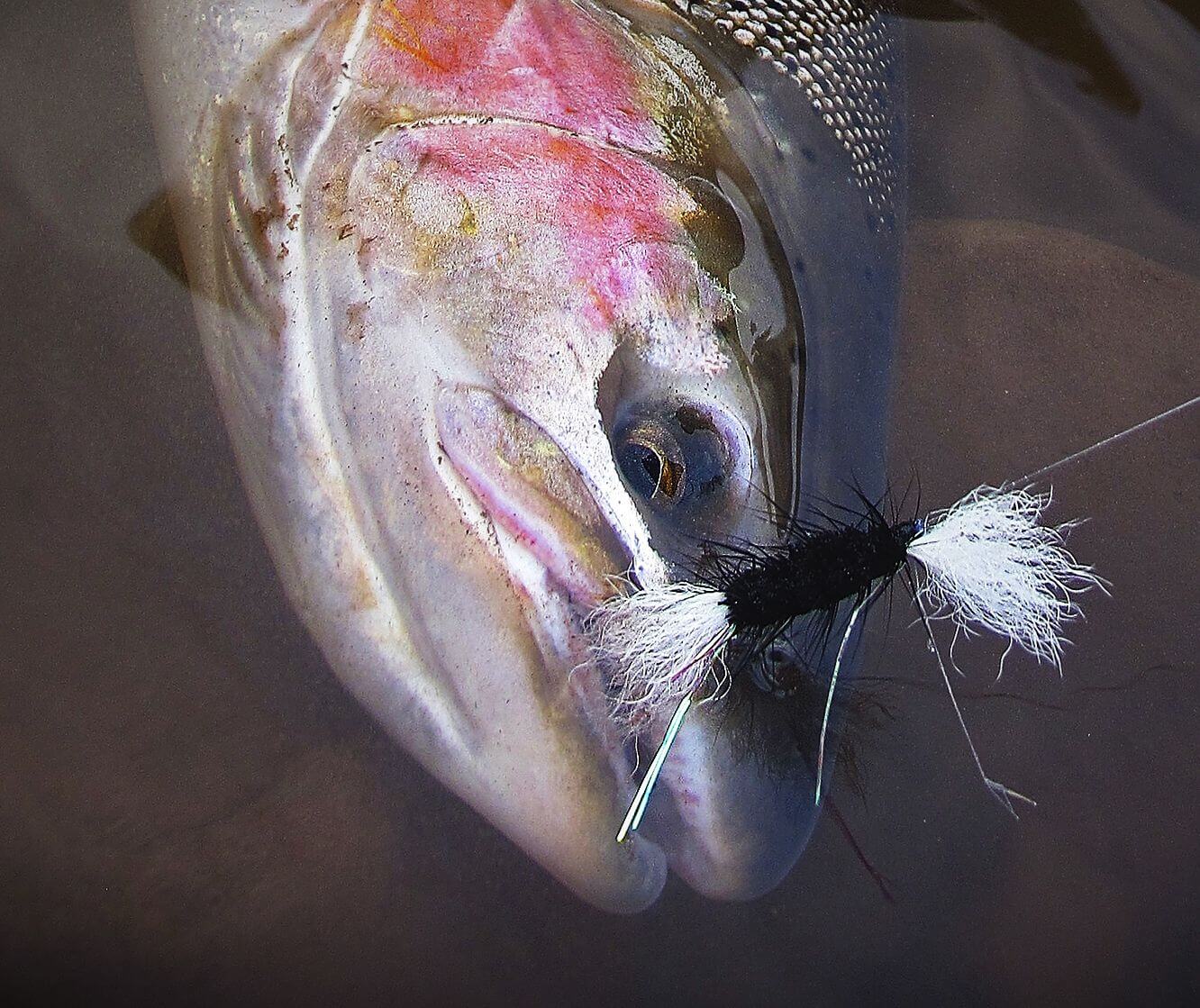
Above: A Skeena River steelhead caught on a dead-drifted Black Tube Bomber ™ Picture with courtesy of Mr Chad Black
Wake fly, dry fly, and skating flies are fishing forms closely associated with fly fishing for steelhead. The way of fishing is only truly efficient when conditions and time are correct, but anglers will prepare and gear up for the climax of fly fishing with great anticipation. Some steelhead anglers would say: Fishing on the top – is the only proper way to catch this great fish.
Surface fishing for Atlantic salmon and sea-trout is a possibility during summer – But when low temperatures starts creeping up on angler in Europa and eastern Canada – salmon and sea-trout turn their attention away from waking and dead drifting flies – But steelhead can go ballistic on wake flies On a cold October mornings
Steelhead angler and Director of Wild Steelhead Funding with Native Fish Society: Mr Tom Derry Fish on the top for steelhead in British Columbia – Tom is using the Monster Tube Caddis steelhead tube fly.
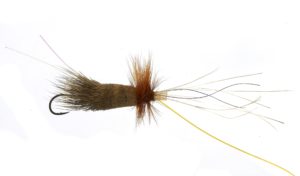
The Monster Tube Caddis steelhead tube fly. – A modern tube wake fly based on the riffling hitch tube fly system – where the leader is inserted on an angle in the tube as opposed to the front of the tube – See more details on the Monster Tube Caddis wake fly in our shop
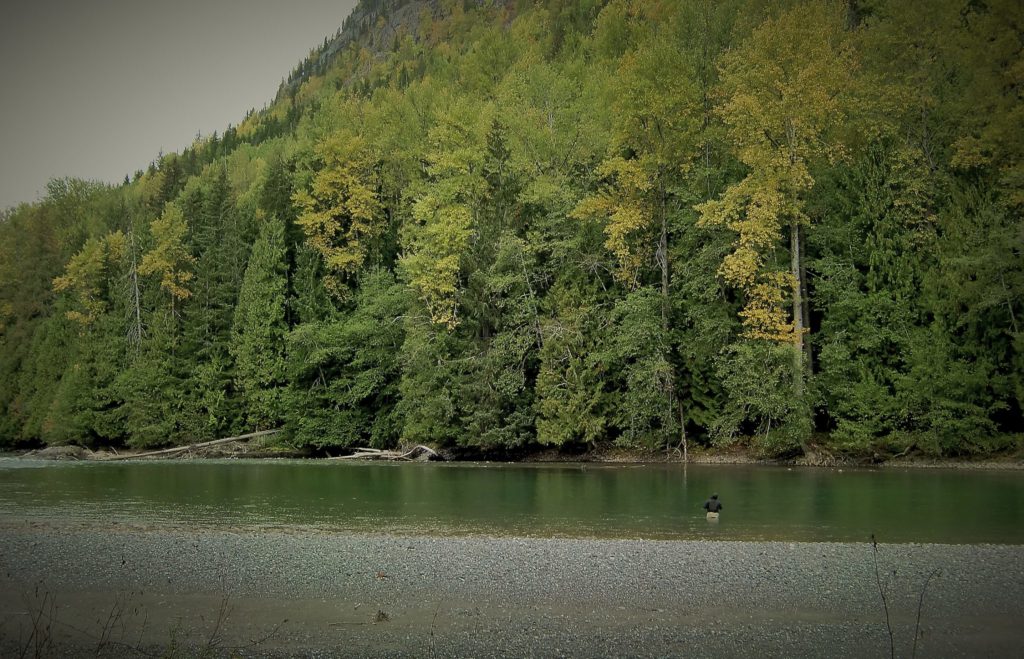
Pulling flies in the surface is about creating a commotion – In some cases the wake could be the main attraction and the fly could literally be secondary
Utilizing Regular Flies for Riffling Hitch Technique
Dragging regular wet flies on the surface (Portland Hitch) or using tiny tube flies fished on an angle is a long-established technique for Atlantic salmon that works fine for steelhead. One could call Riffling Hitch fishing a quiet way of skating or waking a fly – but it would not be all correct as the actual presentation of the fly could be different on a steelhead river versus a salmon river – To see more on the riffling hitch technique see our pages on the subject.
 Bulky Waking Flies for Steelhead: The Impact of Materials
Bulky Waking Flies for Steelhead: The Impact of Materials
In the realm of conventional steelhead wake flies, the incorporation of voluminous, buoyant materials such as deer hair and EVA-foam (Ethylene-vinyl acetate) is a common and effective practice. The substantial size and buoyancy of these materials play a crucial role in creating a pronounced wake as the fly moves across the water’s surface.
Famous versions of the Bomber have been honed into shape to perform well on the surface – when fished across the river.
Steelhead wake flies on tube
Innovative Tube Wake Flies for Steelhead Fishing
We’ve revolutionized the approach to crafting steelhead wake flies by introducing the riffling hitch tube system into known and new steelhead patterns.
Why Tube Flies?
At Fishmadman, we specialize in tube flies designed for surface and sub-surface fishing. Scandinavian anglers widely embrace tube flies, a preference we share due to their versatility and ease of use. These flies enable precise presentations of large and small patterns, accommodating various water flow conditions.
A Simple Solution for Wake Flies
Say goodbye to intricate hitch knots and the need for technical expertise on knot positioning concerning hook slope and river flow. With our adaptation of the riffling hitch system, all you need to do is thread the leader through the hole in the tube’s belly and attach a hook of your choice, and you’re ready to start your fishing adventure.
Our Journey in Steelhead Surface Fishing:
As devoted surface anglers, we recognize the significance of attention to detail and styling in local waters. With over a decade of collaboration with anglers across North America, we’ve successfully developed more than a dozen exceptional steelhead tube wake flies. These flies have gained popularity among guides and steelhead enthusiasts in the North West. (Explore some of these flies here)
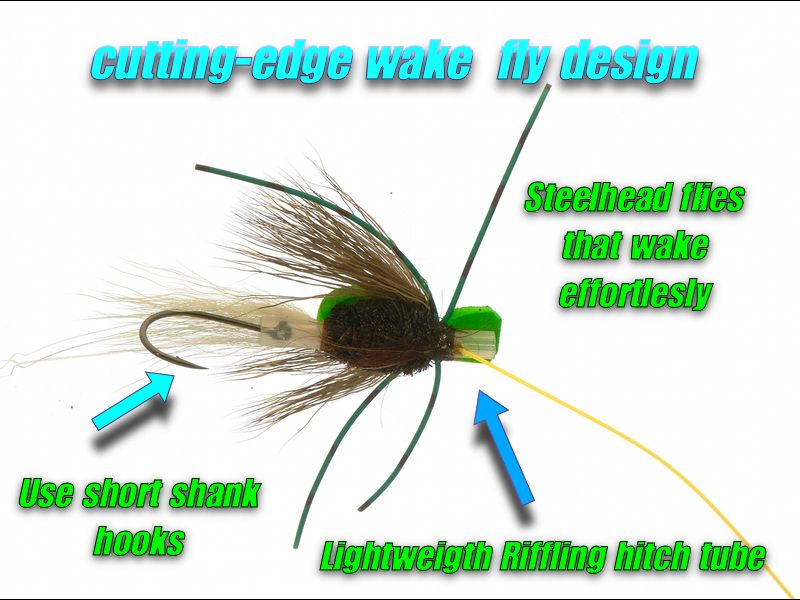
 Tube wake version of the Bomber.
Tube wake version of the Bomber.
It is said that Mr E. Smith designed the first Bomber pattern in the 1960s. Mr Smith designed the fly as a commotion fly to fish Atlantic Salmon in the Miramichi River in New Brunswick. The fly pattern proved very successful on salmon and soon spread to steelhead anglers in the West, who changed the overall design to enable it to wake better. Some even shape their Bomber to work with a dive and pop-up motion.
Right: The Rusty Brown Bomber conceived by steelhead guide John Hazel in 1979. A favourite Bomber pattern with many steel headers – Here, done the Tube Bomber way.
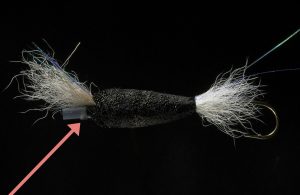
Bomber-influenced wake flies like; Moose Turd – Cigar Butt – Purple Bomber – Air B.C are chosen versions for commotion fishing
Photo: The famous Moose Turd wake fly by Bill McMillan – done the Fishmadman way on our Riffling Hitch Tube – The arrow show`s the entrance hole for the leader. This is a dependable way of getting a fly pattern to pull to the surface and wake. Big and long wake fly patterns benefit much from this transition – like the tube fly fitted with a small wide gape hook (like a 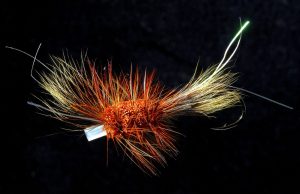
Right: Our version of the classic steelhead fly, the Rusty Brown Bomber, Tied on our Riffling Hitch tube
Babine River style Bombers
We have been fortunate to work with some longtime steelhead anglers on a new Bomber project – producing unique versions of the Bomber styled for rivers like; The Bulkley, Skeena, Kispiox and the Babine.
Above: The Green But Bomber wake fly
These two Bomber wake patterns were designed to fit our riffling hitch tube system by steelheader Mr Loren Irving from Oregon. His fishing inspired the fly composition and styling partners Mr Frank Cammack and Mr Jim Bussard, two veteran steelheaders from Oregon.
Above: The Brown Bomber wake fly
Above: A favourite Bomber colour both for steelhead and Atlantic Salmon: The Aqua Blue Bomber wake fly
Wake and skate fly with a very different approach
 The Ska-Opper
The Ska-Opper
Some top water flies for steelhead are made to plough through the surface. Some are made to create a moderate wake; others, like the Ska-Opper or Quigley’s Dragon Gurgler, are designed for a more active life on the surface: bobbing, making a wake and spitting water.
Left: The Ska-Opper: A modern Skate/Popping fly by steelhead guide Mr Scott Howell – Here done on our Riffling Hitch tube. Buy the Ska-Opper wake fly tied on a tube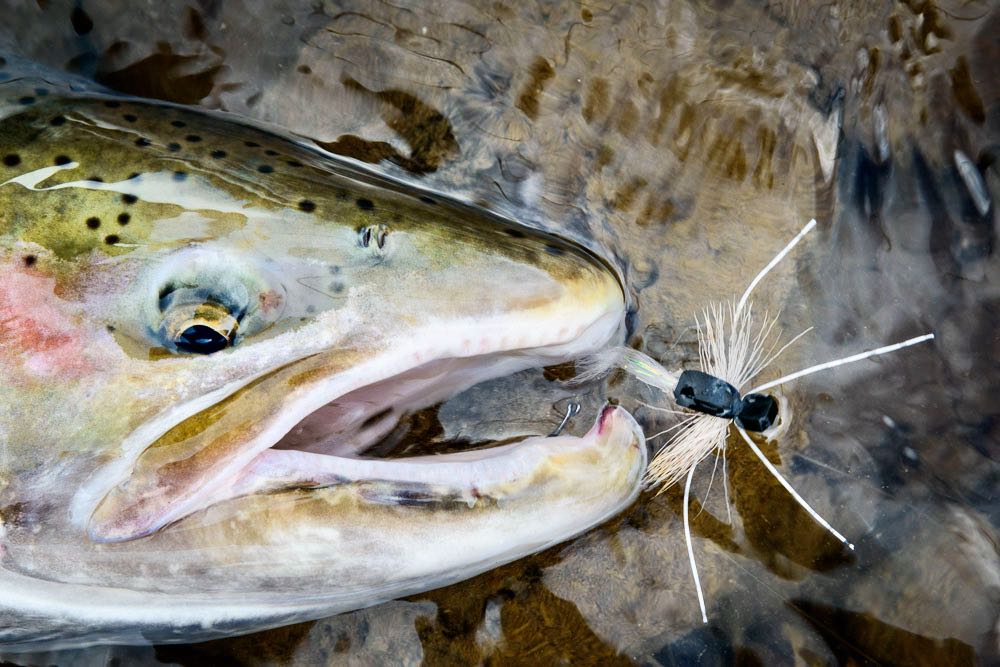
The Grease Liner
A classic steelhead wake fly pattern designed by Mr Harry Lemire in 1962. This pattern was once everybody’s favourite fly and a “must-have wake fly” in the fly box – but over time, flies that wake with greater ease were to substitute the Grease Liner.
We tie the Grease liner on our Riffling Hitch tube, and you will find that it wakes as well as any modern wake fly.
The Grantham Sedge, a fly to create a small wake
Here we have made a version of the superb Grantham Sedge wake fly – Designed by Mr Ron Grantham – Fly is tied on our Riffling Hitch Tube. The tube will allow the hook to be turned in various positions facing down, up or on an angle allowing for different hook-up options.
The Grantham sedge wake fly works brilliantly in the back end of the pool way into the slick glide with a tiny wake
The Monster Tube Caddis
The WAKE version of our Monster Tube Caddis – A special design we have perfected over the last years – Developed for steelhead fishing – but has also proved to work for salmon in lakes and rivers – A unique caddisfly imitation designed to bring curious fish to the top. Buy the wake Monster Tube Caddis here
The FlashBack Bug
Steelhead anglers have been fishing this new wake fly pattern on different rivers in British Columbia and Oregon since the summer of 2014, and the results have been great. It was later named The FlashBack Bug.
We have tied it in 3 sizes similar to flies tied on # 1 – 4 – 8 hooks
It features our Riffling Hitch tube system and wakes perfectly in rough and calm water.
 Read more about top-water tactics for steelheads.
Read more about top-water tactics for steelheads.
Written by top water pro and camp manager; Chad Black from Nicholas Dean Lodge, Situated in the Lower Skeena Region. Terrace, BC, Canada. Chad Black and some of the guides from the lodge have helped us make our wake fly series –
Check out the tube wake flies we do  Use small bugs for fish hiding in slow water
Use small bugs for fish hiding in slow water
Bugs are small miniature salmon and trout flies, mostly made with a deer hair body, tied on # 8 – 12 single hooks. Either low-water salmon hooks with an up-eye or stronger down-eye trout fly hooks. It is a fly designed to be fished as a so-called dead-drifting fly on the surface. Just below the surface or across the river as a form of hitch/commotion fly, bugs may be fished below the surface as a traditional wet fly or as a comotion fly in slow pools
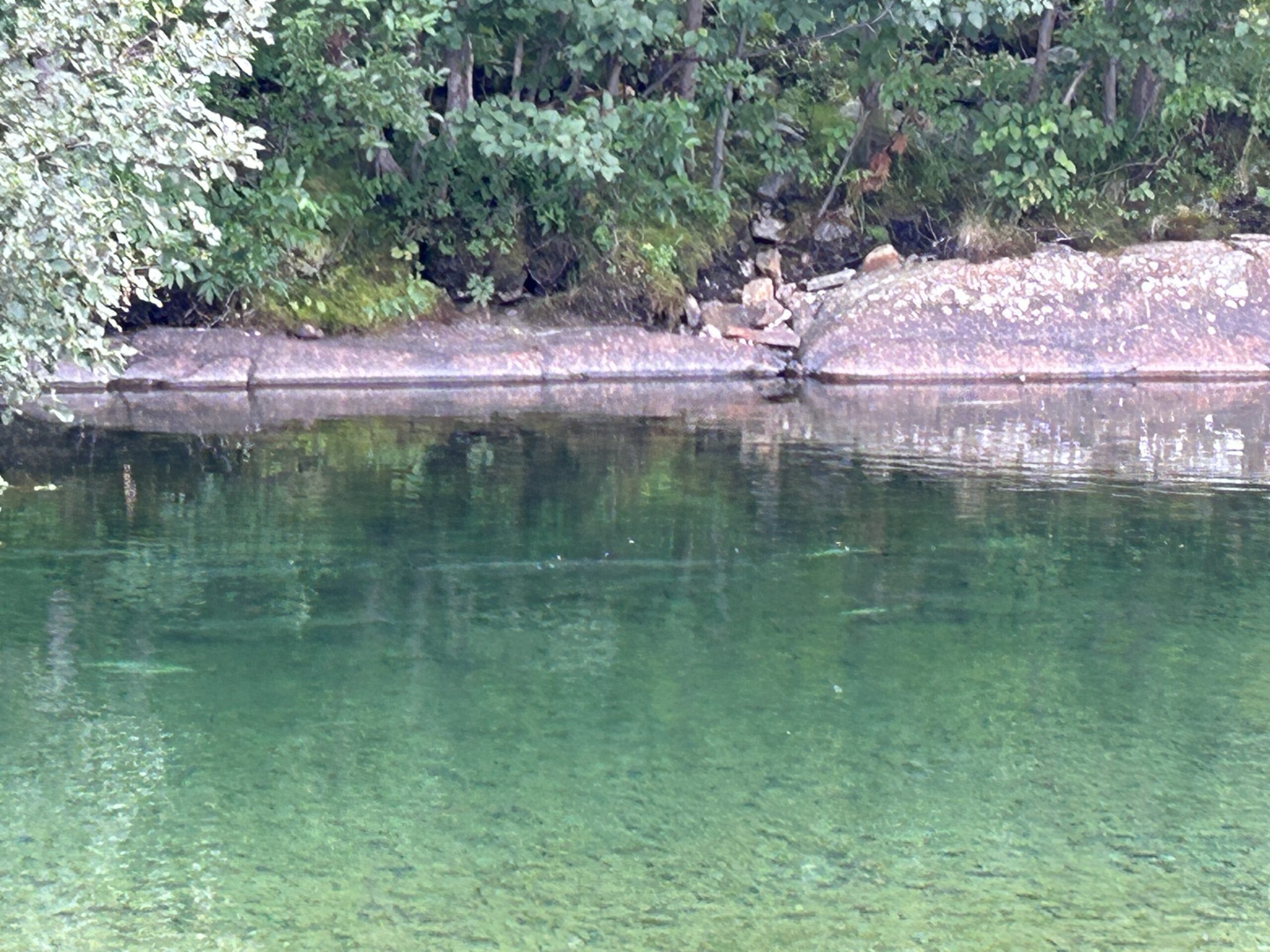
Hiding in slow pools
Salmon and trout hiding out in a slow pool like those fish seen in the image above is not an uncommon site for anglers pursuing trout and Atlantic salmon in river. They are typically uninterested fish, but if new fish enter the pool or weather conditions change, some fish may wake up and grab your fly.
Retrieving the fly
A spot like this demands that you put some movement into your fly, and I think bugs are some of the best flies you can use in such a place. Tiny flies with deer hair bodies seem to have the right balance in the water column, allowing you to make a good stop-and-go presentation and letting the bug hang in the water column for a short while in between pulls.
Read more on Bugs and bug fly fishing on our blog here

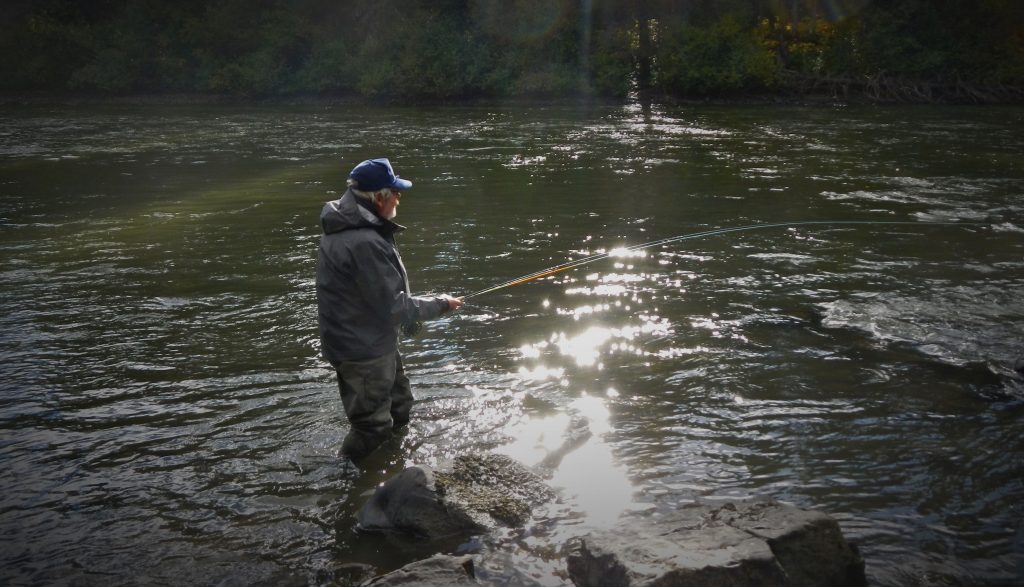
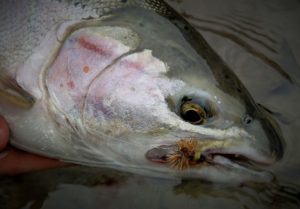 Image Caption: A stunning hen fish caught using a Steelhead Bee, a fly pattern created by Mr. Roderick Haig-Brown from Vancouver.
Image Caption: A stunning hen fish caught using a Steelhead Bee, a fly pattern created by Mr. Roderick Haig-Brown from Vancouver.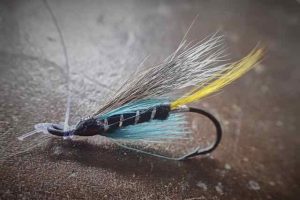
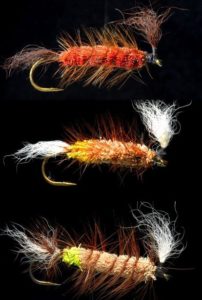 Bulky Waking Flies for Steelhead: The Impact of Materials
Bulky Waking Flies for Steelhead: The Impact of Materials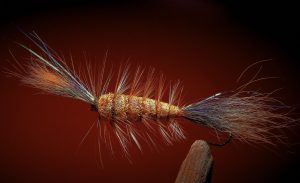 Tube wake version of the Bomber.
Tube wake version of the Bomber.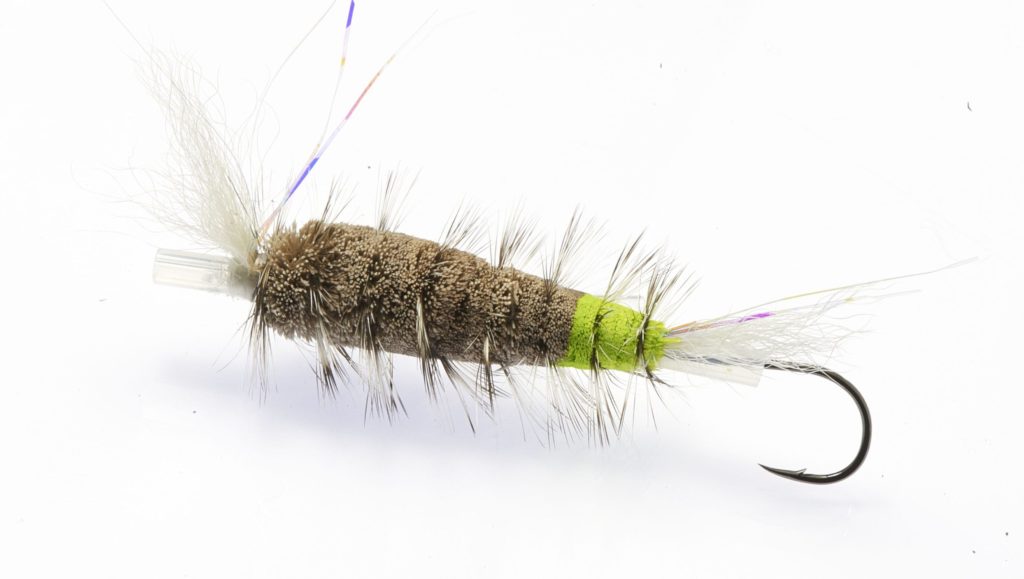
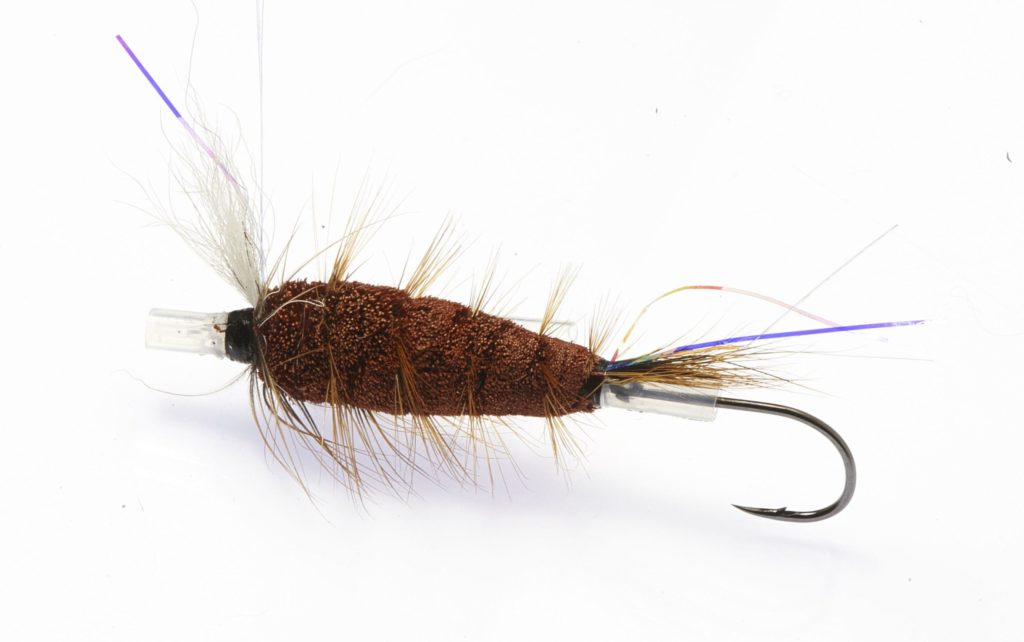
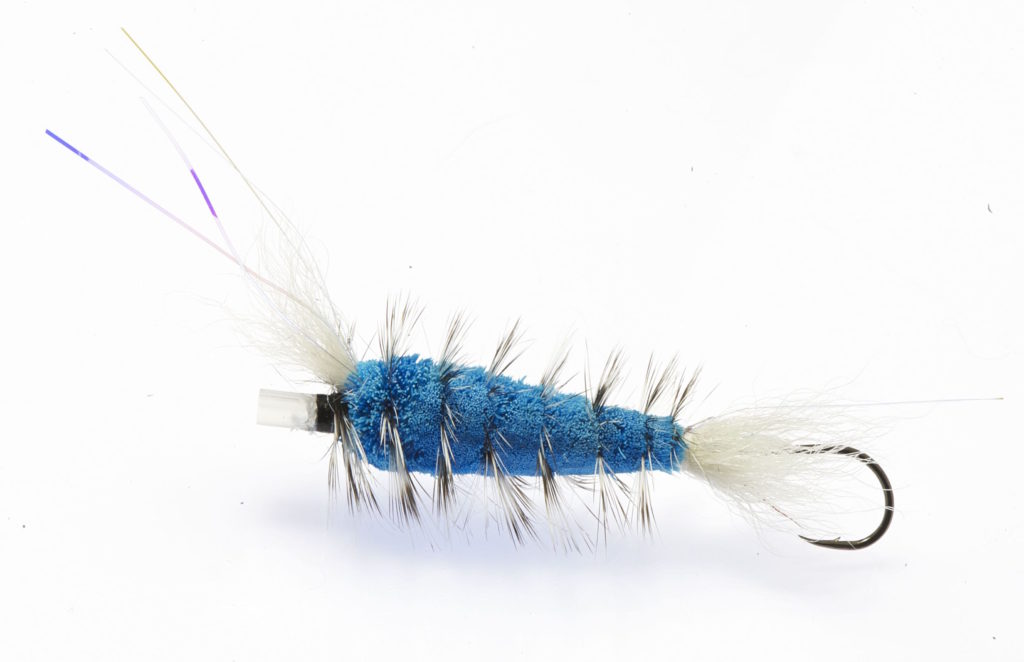
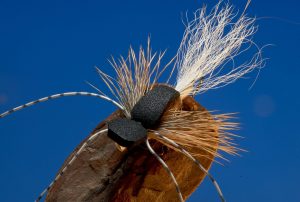
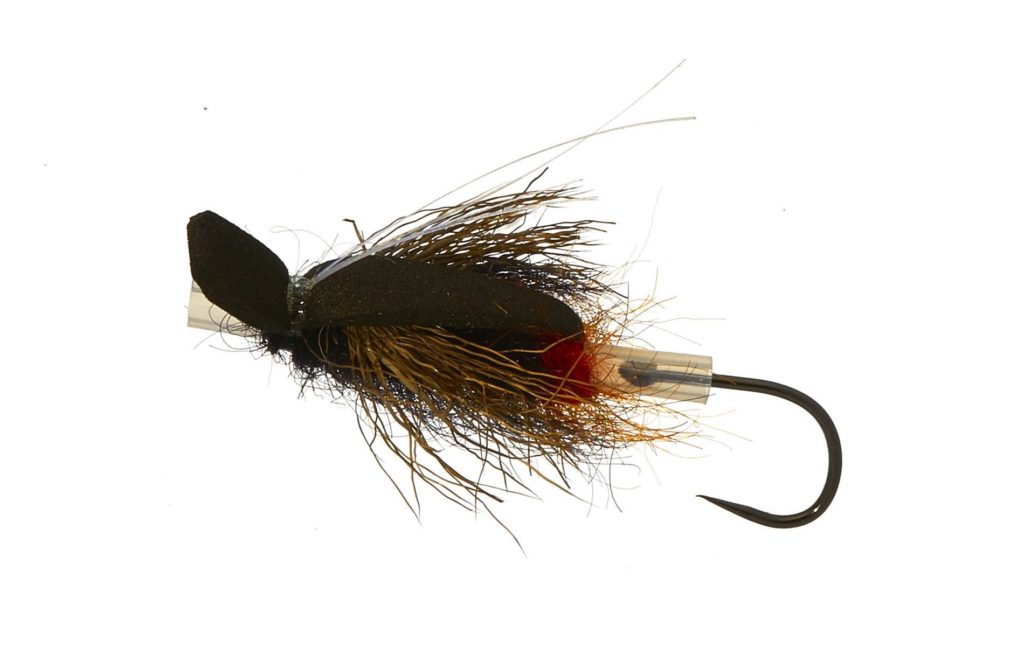
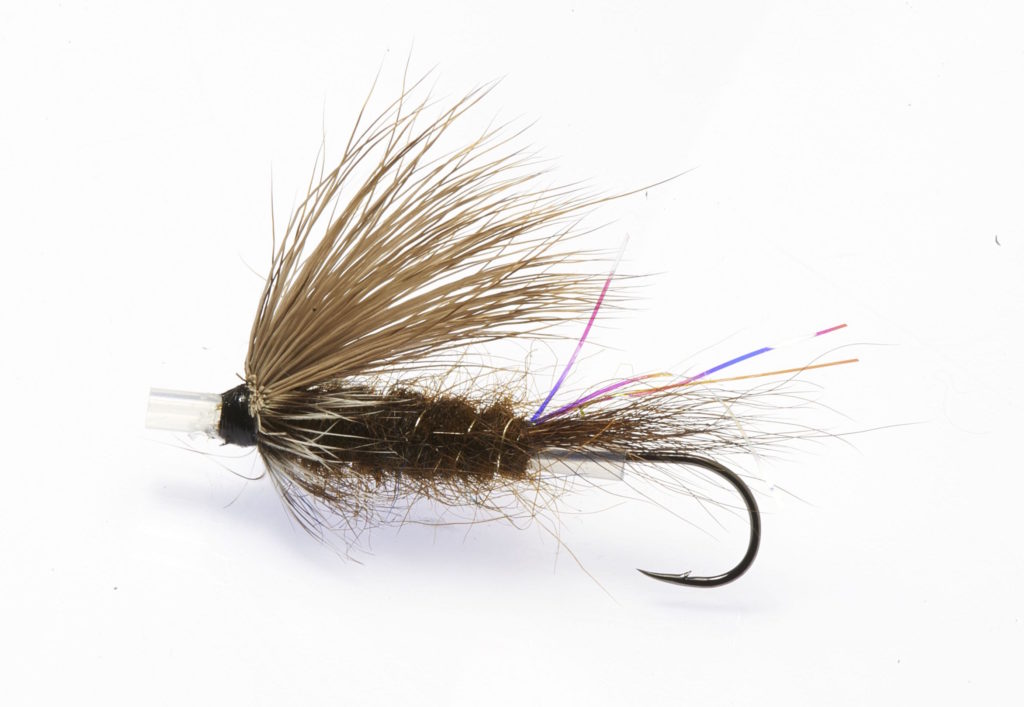
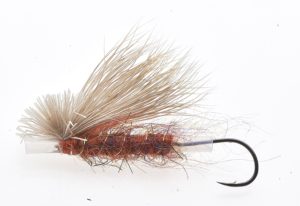
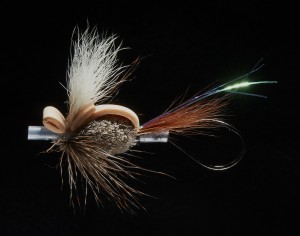
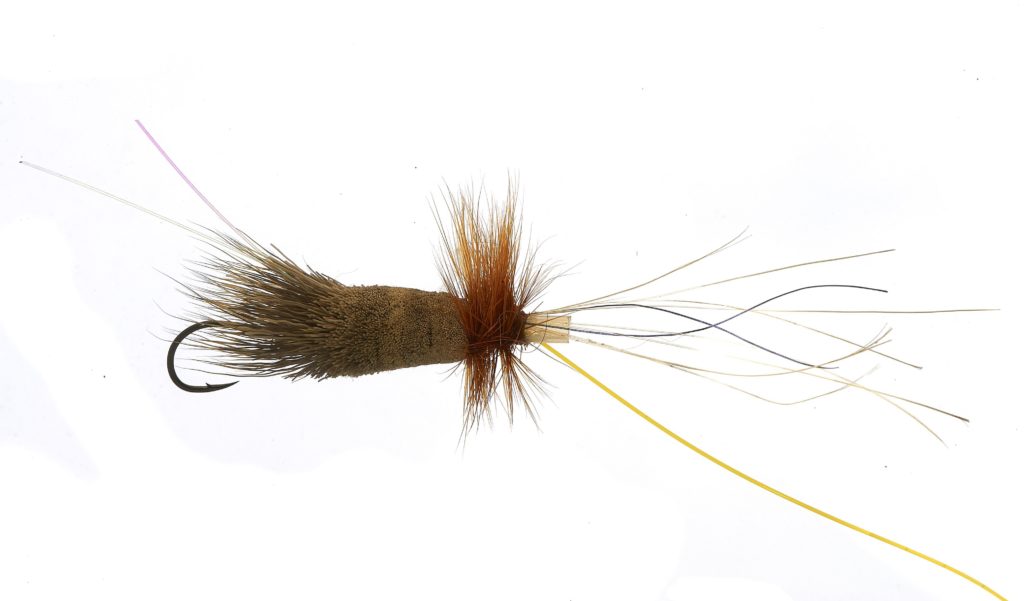
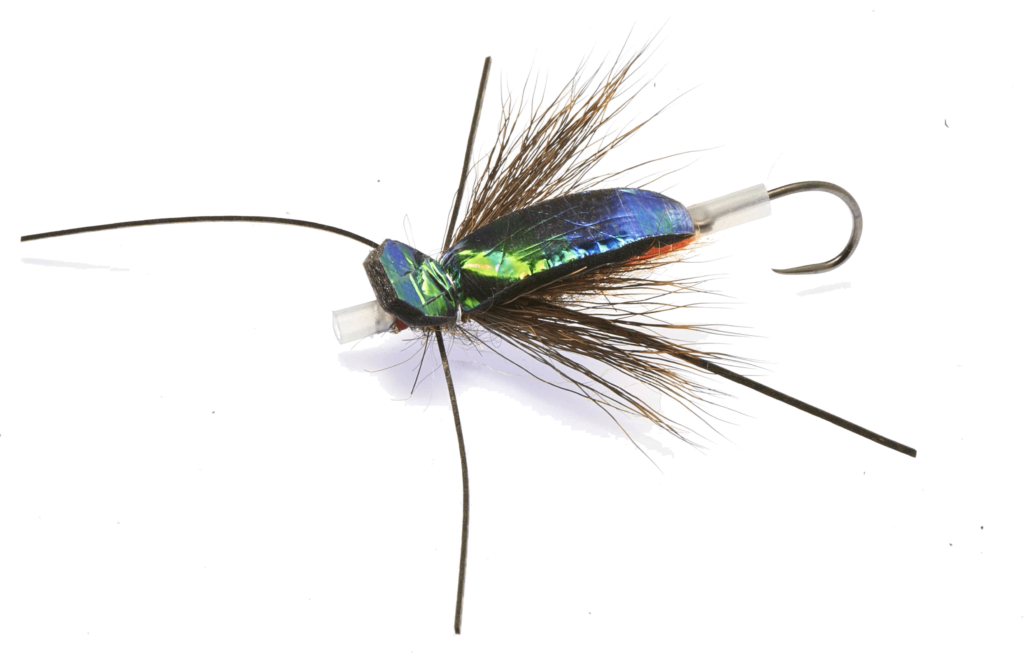
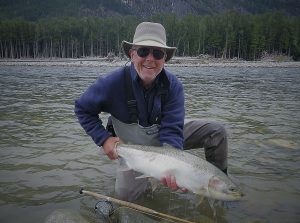
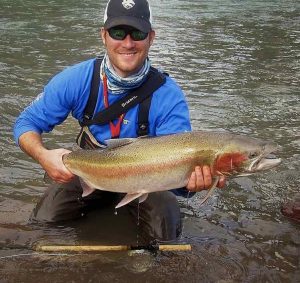 Read more about top-water tactics for steelheads.
Read more about top-water tactics for steelheads.
